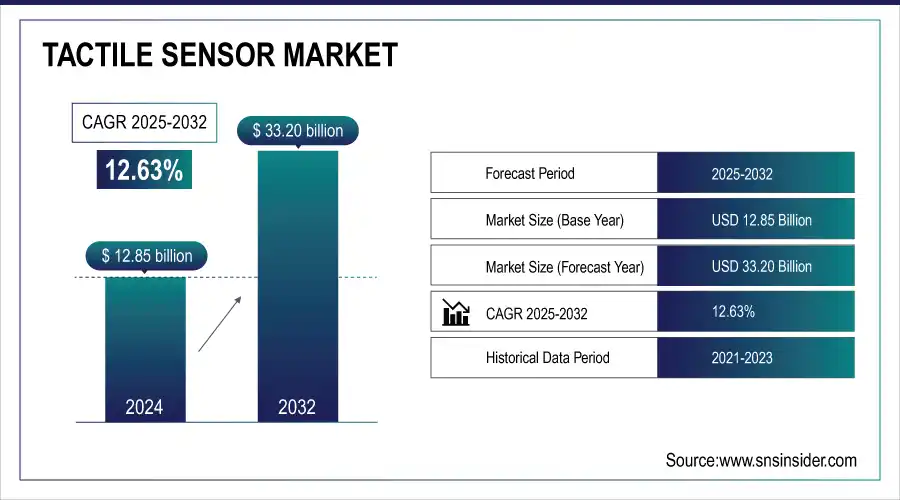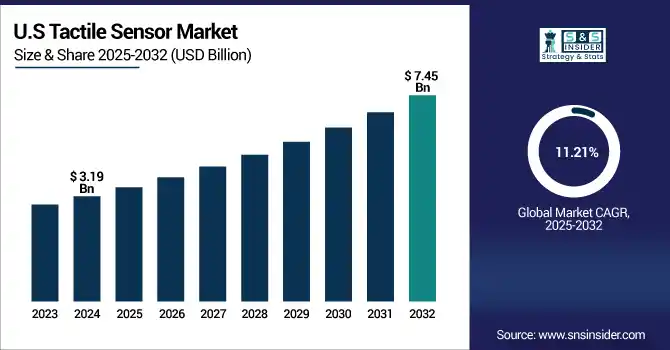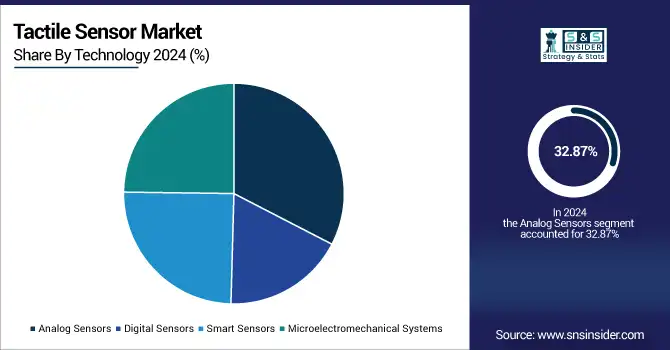Tactile Sensor Market Size & Trends:
The Tactile Sensor Market Size was valued at USD 12.85 billion in 2024 and is expected to reach USD 33.20 billion by 2032 and grow at a CAGR of 12.63% over the forecast period 2025-2032.
The global Tactile Sensor Market is segmented in much more descriptive way by type, application, technology and end-users, and it further research and analysis of the industry, and also gives the concept for the future trends. Such classifications allow a flexed evaluation of the core growth verticals, technology innovation and segment level performance indicators. Through this well-structured segmentation, stakeholders can easily draw actionable insights on where the demand is growing, what technologies are being adopted and how market dynamics and investments are fluctuating across different regions and industries until 2032.
-
Tactile sensors are integrated into nearly 65% of wearable health monitoring devices to track pressure and motion data.
-
Touch-sensitive interfaces powered by tactile sensors are used in over 80% of smartphones and tablets released after 2022.

To Get More Information On Tactile Sensor Market - Request Free Sample Report
The U.S. Tactile Sensor Market size was USD 3.19 billion in 2024 and is expected to reach USD 7.45 billion by 2032, growing at a CAGR of 11.21%over the forecast period of 2025–2032.
The market growth is mainly driven by growing demand in smart wearables, automation in manufacturing, and faster adoption of these devices in healthcare. Strong R&D investment and established sensor manufacturers along with industrial infrastructure further bolster the U.S. demand as a critical contributor in the global eco-system of tactile sensor.
-
Nearly 55% of U.S. manufacturing facilities have adopted automation solutions that include robotic systems embedded with tactile sensors.
-
Over 65% of wearable health tech products in the U.S. incorporate tactile sensors for pressure and motion detection.

Tactile Sensor Market Dynamics:
Key Drivers:
-
Increase in adoption of automation and robotics across industries raises the need for intelligent touch-sensitive solutions
The growing trend of deploying automated systems in manufacturing, logistics, and service industry will further fuel the demand for tactile sensors. The satisfaction of these sensors provides important feedback helping the robotic systems to identify touch, pressure, and texture and therefore allow safer and more effective human–machine interaction. Touch is an essential sensory input for collaborative robots (cobots), which use various sensors to function safely alongside humans. With advancements in automation towards smarter production lines and autonomous systems, tactile sensors are emerging as a key building block that can significantly improve performance and mitigate risks.
Tactile sensor integration has increased by 45% in industrial robots between 2020 and 2024, driven by demand for precision handling.
Over 70% of collaborative robots deployed in industrial environments now use tactile sensors for safety and object interaction.
Restraints:
-
Advanced tactile sensors are expensive and complex to design which limits their use in cost-sensitive sectors.
However, even with high precision and reliability, the cost of tactile sensors remains a barrier to higher market penetration levels. This integration into existing systems and their calibration is specific and increases the cost of the overall project. This restricts their attractiveness in low-cost industries like small manufacturing, consumer goods, or developing countries. In addition, the total cost of ownership is exacerbated due to higher skills requirements for their implementation and maintenance, making widespread adoption challenging, despite improvements in tactile sensing awareness.
Opportunities:
-
Increased integration of consumer IoT and smart home ecosystems creates long-term market potential
Smart homes and IoT-enabled environment is expanding opportunities for tactile sensors. Smart appliances, home security systems, touch-enabled control panels, and similar devices demand responsive tactile feedback to ensure intuitive functionality. These sensors, when integrated into this system, assist in getting the user Interaction, automation, and real-time diagnostic. With homes and personal environment moving towards smart trends, there will be a high demand for touch-based sensing solutions, creating a good long term growth opportunity for Tactile Sensor Market in consumer-centric industries.
-
According to research, global IoT device count surpassed 15 billion in 2023, with a growing share integrating tactile sensing for enhanced functionality.
-
Touch-enabled control panels accounted for 42% of smart home user interfaces deployed globally in 2024.
Challenges:
-
Absence of standardization in tactile sensor technologies promote challenges in integration and interoperability across platforms
Development standards for sensors deployed in smart devices and systems are somewhat fragmented, creating challenges for manufacturers to provide a level of interoperability across devices and systems at the Tactile Sensor Market level. Other sensing principles, different calibration methods, and various data formats, lead to integration problems in multi-component applications. This non-collaboration hinders scalable solution deployment, particularly in environments where other types of technologies need to interact with each other. The lack of single protocols or frameworks is resulting in longer and costlier product development cycles, which is proving to be a big obstacle in terms of market expansion and global adoption.
Tactile Sensor Market Segmentation Analysis:
By Type
In 2024, the Capacitive sensors segment held the highest revenue share of around 22.55% of the overall Tactile Sensor Market share. The popularity of the technology to provide the base that makes touchscreens, consumer electronics, and control interfaces that their dominance rests upon. They are also preferred due to their high sensitivity and quick response time, low power functionality, and small size. As an example, Synaptics Incorporated provides directly important capacitive sensing products for smart devices. Along with their low cost and seamless integration, this further confirms their hold on all consumer, industrial, and medical applications.
The piezoelectric sensors segment is anticipated to expand at the rapid CAGR of nearly 15.40% between 2025 and 2032. Their ability to provide accurate feedback in different environments and also in mission-critical applications is driving this growth. Piezoelectric sensors have become essential as ever great demand of maintaining accuracy in tactile feedback especially in Robotics and medical equipment. TDK Corporation: Piezoelectric sensor solutions under development to serve these needs This positioning of high-precision systems as a centerpiece of next-generation innovation is what makes them essential.
By Application
The largest revenue share of around 27.15% of the tactile sensor market in 2024 is having the consumer electronics segment. This has been mainly because of the extensive use of tactile sensors in smartphones, tablets, wearables and gaming devices. Such sensors improve user experience and usability. Apple Inc., for instance implements high-end tactile sensing technologies for haptic feedback, pressure-sensitive screen, etc. While other industries are catching up fast as tech companies keep innovating, the consumer electronics market is still where tactile sensor technologies are proliferating the quickest.
Robotics segment is projected to achieve the highest growth rate, anticipating a CAGR of almost 13.60% during the period of 2025–2032. This rise is due to increasing automation demand in logistics, healthcare, and manufacturing. Robots with tactile sensors have the ability to sense pressure and adjust to human–robot interaction environments. One company, the Shadow Robot Company, is in the vanguard of this field, designing sophisticated tactile-sensing robotic hands. The convergence of AI and robotics also indicates the need for machines to perceive their environment, projected to increase demand for this segment quite quickly.
By Technology
In 2024, the Tactile Sensor Market was dominated by the analog sensors segment with approximately 32.87% share of revenue. They also have a solid and straightforward architecture well-suited for legacy and industrial systems needing low-latency, and highly reliable performance. As a leading provider of analog tactile sensing solutions, Tekscan, Inc. has enabled the unique capabilities of tactile sensing to be broadly deployed for industrial and diagnostic applications. They are, therefore, commonly favored where direct and analog signal output in near real-time is essential a key factor in their continued domination up to today.
The fastest growing MEMS segment (14.16% between 2025-2032) One of the main growth drivers of this market is the trend for miniaturization of electronics and healthcare in which portable, compact, sensitive sensors are made possible. MEMS-based tactile sensors that can measure multi-axis touch are being developed by companies such as STMicroelectronics in exciting small form factors. The demand for smart sensing is rapidly increasing, which in turn, is driving their adoption in wearables, implantable, and intelligent machines.

By End-Users
Consumer electronics segment held the largest revenue share of the Tactile Sensor Market, accounting for around 35.97% in 2024. That has to do with the evolution of consumer tech and the production of touch-heavy devices. Interface responsiveness and user satisfaction can be increased with tactile sensors. For example, market-leading companies like Samsung Electronics are integrating these sensors into their smartphones, tablets, and smart appliances. Consumer Electronics: As consumer electronic remains a key sector for tactile sensor due to continuous product innovation cycles.
The healthcare shows fastest growing CAGR of 14.97% from 2025 to 2032. Adoption of high-precision sensors used in prosthetics for diagnostics and surgical robotics are driving their usage. For example, Medtronic plc is investing in smart medical devices that have embedded tactile sensors for ongoing monitoring and better patient outcomes. With the medical industry leaning toward automation and remote care, confirming tactile sensing technologies have become vital in modern medical solutions.
Tactile Sensor Market Regional Outlook:
North America held the biggest revenue share of about 32.80% in the Tactile Sensor Market. Such leadership is driven by healthy adoption in healthcare, aerospace and industrial automation, as well as strong R&D and the presence of major companies providing sensor technologies. This is complemented by government efforts to accelerate automation, coupled with the use of advanced robotics, which drives demand, thus making North America a driving force of innovation and deployment of tactile sensors across a number of verticals.
-
The U.S. dominates the North American Tactile Sensor Market due to its strong presence of leading tech companies, advanced R\&D infrastructure, and high adoption in consumer electronics, robotics, and healthcare sectors, supported by consistent innovation and early technology deployment.

Get Customized Report as Per Your Business Requirement - Enquiry Now
Asia Pacific is projected to lead the market with the fastest growth rate, having a CAGR of nearly 15.14% over 2025-2032. Regional growth is driven by rapid industrialization, flourishing electronics manufacturing and the rising investments in robotics and smart healthcare. China, Japan, South Korea and India have been at the forefront in terms of production and usage with regards to sensors. Asia Pacific is also the fastest-growing tactile sensor region in the world, due to rapidly expanding consumer tech markets, as well as government initiatives pertaining to automation and smart cities.
-
China dominates the Asia Pacific Tactile Sensor Market due to its massive electronics manufacturing base, rapid industrial automation, strong government support for AI and robotics, and presence of major local players driving large-scale adoption across consumer, automotive, and healthcare sectors.
The Tactile Sensor Market in Europe is mainly driven by the development of automotive, healthcare, and industrial automation. Strong collaborative R&D investments, growing Industry 4.0 standards adoption, and rising demand for smart medical devices are factors that will bolster growth of the market in this region. Germany, France, and the UK are among the countries leading this trend with government support for digitalization, and sensor-based technologies.
-
Germany dominates the European Tactile Sensor Market due to its robust automotive and industrial automation sectors, strong engineering expertise, and early adoption of Industry 4.0 technologies, supported by major manufacturers and continuous investment in sensor innovation and smart factory initiatives.
In Middle East & Africa, due to rapid adoption of technological innovation and smart infrastructure projects, UAE is spearheading the Face Mask Tactile Sensor Market. Brazil is the dominant country in the region, which is based on its strong automotive and manufacturing sectors, increasing industrial automation, and growing investments in electronics and healthcare technologies integrated with advanced tactile sensors.
Key Players:
Major Key Players in Tactile Sensor Companies are Tekscan, Inc., Pressure Profile Systems, Inc. (PPS), Tacterion GmbH, Touchence Inc., Synaptics Incorporated, FutureShape GmbH, Sensel Inc., Baumer Group, Nissha Co., Ltd., Schott AG.
Recent Developments:
-
In February 2025, Tekscan partnered with FLEXOO to enhance printed tactile sensor capabilities, reflecting its drive toward more flexible, scalable solutions for industrial and wearable applications.
-
In April 2025, Synaptics launched the S3930 series touch controller IC optimized for foldable OLED displays an advancement enhancing touch sensitivity and FC performance in next-gen smartphones and foldable devices.
| Report Attributes | Details |
|---|---|
| Market Size in 2024 | USD 12.85 Billion |
| Market Size by 2032 | USD 33.20 Billion |
| CAGR | CAGR of 12.63% From 2025 to 2032 |
| Base Year | 2024 |
| Forecast Period | 2025-2032 |
| Historical Data | 2021-2023 |
| Report Scope & Coverage | Market Size, Segments Analysis, Competitive Landscape, Regional Analysis, DROC & SWOT Analysis, Forecast Outlook |
| Key Segments | • By Type (Analog PLL, Digital PLL, All-Digital PLL, Frequency Synthesizers) • By Component (Phase Detector, Low Pass Filter, • By Type (Resistive Sensors, Capacitive Sensors, Piezoelectric Sensors, Optical Sensors, Magnetic Sensors), • By Application (Robotics, Consumer Electronics, Healthcare, Automotive, Industrial Automation), • By Technology (Analog Sensors, Digital Sensors, Smart Sensors, Microelectromechanical Systems), • By End-Users (Aerospace, Manufacturing, Healthcare, Automotive, Consumer Electronics). |
| Regional Analysis/Coverage | North America (US, Canada, Mexico), Europe (Germany, France, UK, Italy, Spain, Poland, Turkey, Rest of Europe), Asia Pacific (China, India, Japan, South Korea, Singapore, Australia,Taiwan, Rest of Asia Pacific), Middle East & Africa (UAE, Saudi Arabia, Qatar, South Africa, Rest of Middle East & Africa), Latin America (Brazil, Argentina, Rest of Latin America) |
| Company Profiles | Tekscan, Inc., Pressure Profile Systems, Inc. (PPS), Tacterion GmbH, Touchence Inc., Synaptics Incorporated, FutureShape GmbH, Sensel Inc., Baumer Group, Nissha Co., Ltd., Schott AG |

